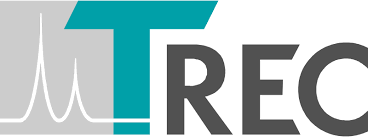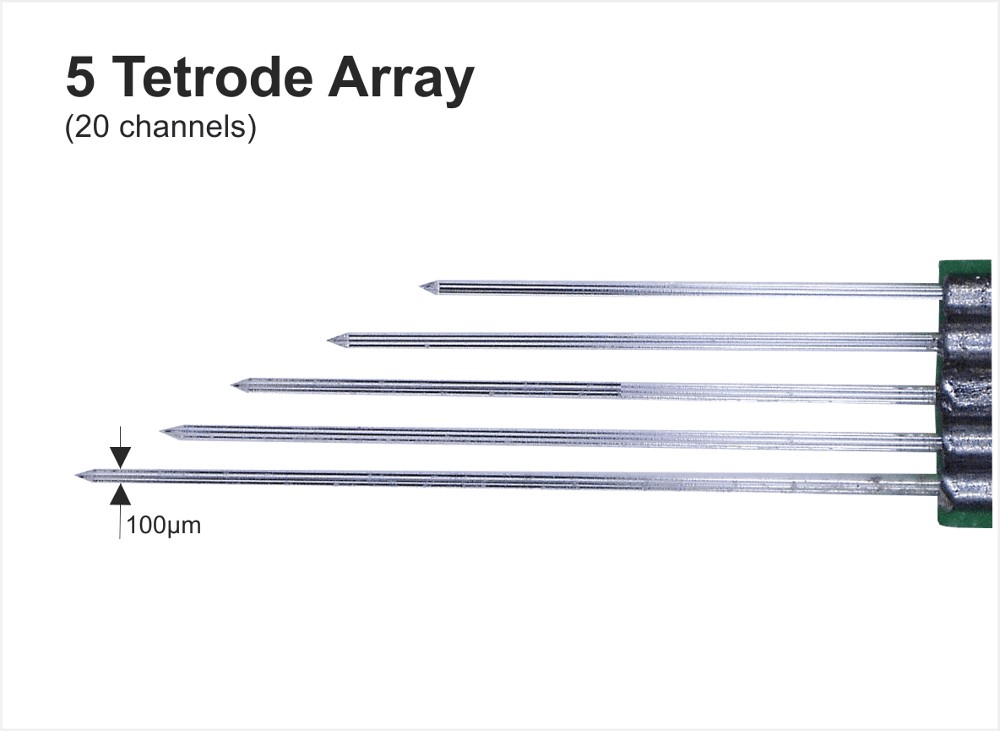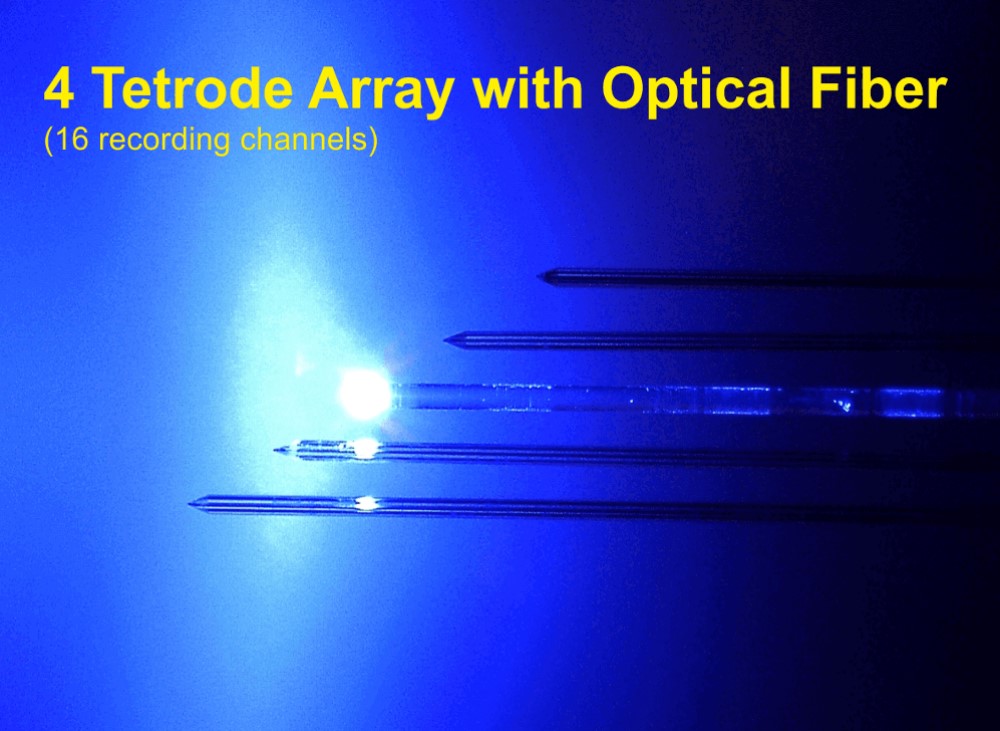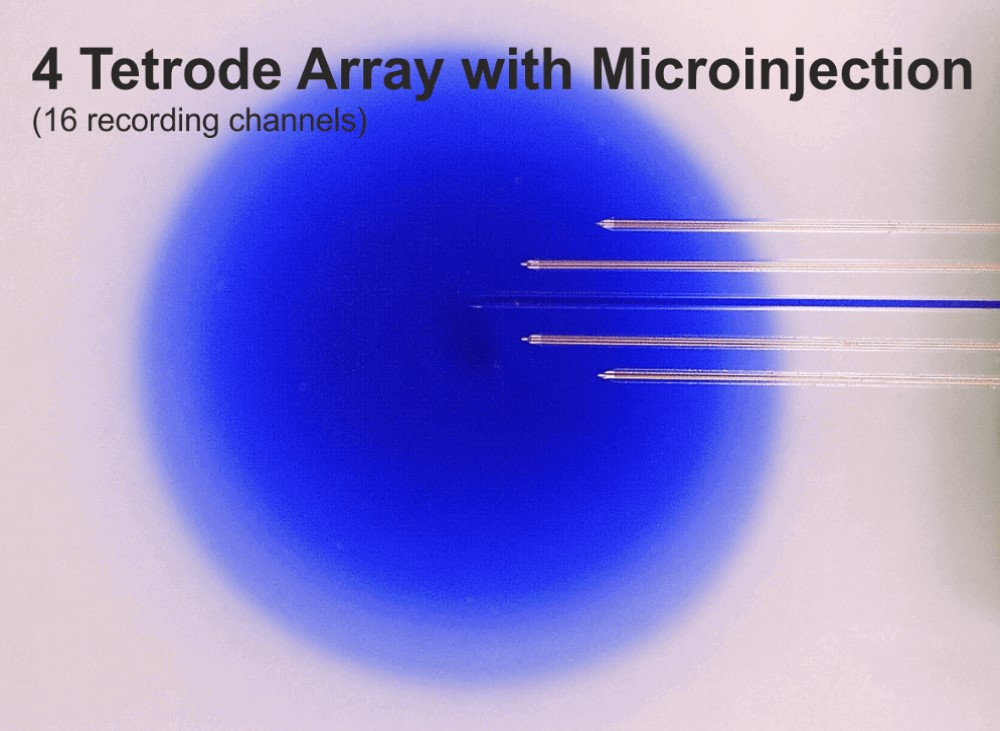Premium Neural Electrode Arrays
Electrode, Tetrode & Heptode array
Premium Neural Electrode Arrays
Electrode, Tetrode & Heptode array
Thomas RECORDING is the market leader of microelectrode recording techniques. The unique quartz glass insulated platinum/tungsten electrode technique is at the frontend of neural interface technology because it produces less tissue damage than silicon probes.
Key features:- Material:Quartzglass insulated Platinum/Tungsten
- Unique manufacturing technique offers high reproducibility of tip geometry
- Tip geometry: highly centered metal core
- Signal quality: very good signal to noise ratio
- Quartz glass offers better electrical characteristics as borosolicate glass
- Tip shape: different tip shapes avaible with tip diameters in the µm range
We´re sorry, there is no content available right now. Please contact us for further information.
OVERVIEW
Our handcrafted and customized neural electrode arrays can be divided into two parts: the electrode array and the carrier unit.
The electrode array is the interface to the neural tissue and can consist of recording electrodes like
- single core electrodes
- tetrodes (4 core electrodes)
- heptodes (7 core electrodes)
and stimulation sites like
- optical stimulation fiber,
- electrical stimulation electrodes and
- injection cannulas (drug delivery).
The carrier unit provides the interface between the electrode array and the external instrumentation (preamplifiers).
Each carrier unit includes a specific connector (e.g. Omnetics). The same electrode array can be combined with another carrier unit offering you a high flexibility in the configuration of neural probes to meet your specific experimental requirements.
 Figure 1: Thomas Neural Electrode Array
Figure 1: Thomas Neural Electrode Array
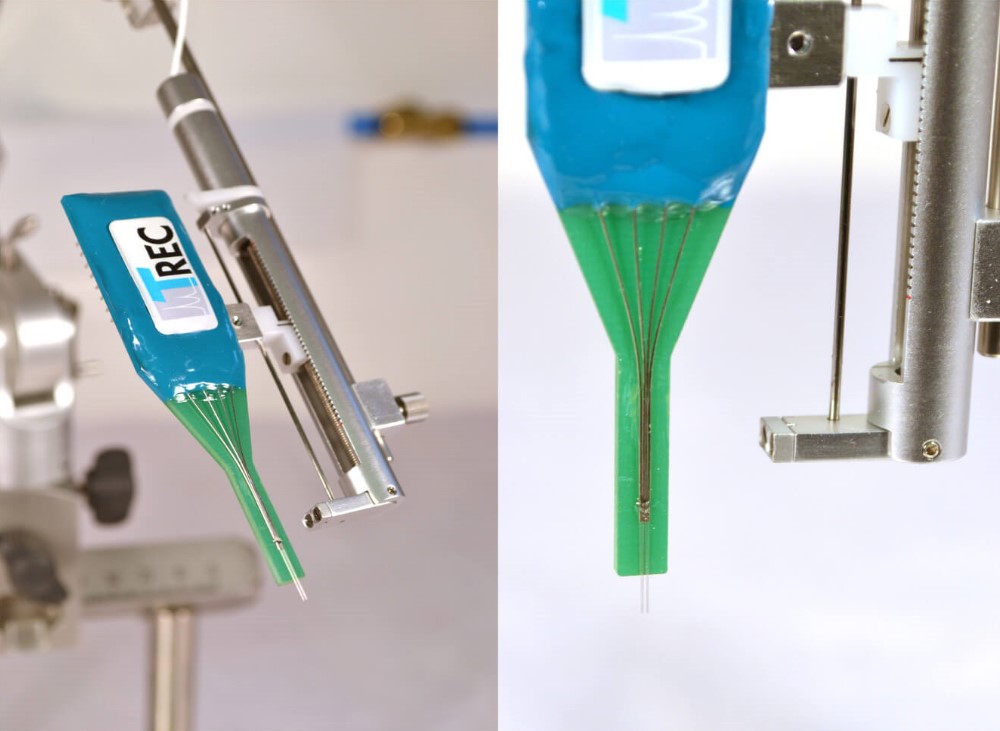 Figure 10: TREC neural probe mounted to a Thomas Motorized Electrode Manipulator (MEM)
Figure 10: TREC neural probe mounted to a Thomas Motorized Electrode Manipulator (MEM)
Use with Thomas RECORDING Microdrive
Beside the neural probes we also offer bidirectional motorized and software controlled microdrives for moving Thomas neural probes with high precision to different depths of the brain. The Thomas Motorized Electrode Manipulator (MEM) is well suited to drive the Thomas Neural Electrode Arrays with high precision.
Thomas RECORDING Array Electrodes are available in many configurations. Each Array Electrode can be customized for optogenetical applications, drug delivery or electrical stimulation.
POSSIBLE SETUPS
Standard Probes
Thomas RECORDING standard Neural Electrode Arrays are manufactured using the quartz glass insulated platinum/tungsten microelectrode technology originally developed at University of Marburg, Germany.
Thomas RECORDING offers a wide variety of Neural Electrode Arrays. The standard Neural Electrode Array consist of a number of single electrodes, tetrodes or heptodes in linear or concentric arrangement.
The arrays can be customized according the users requirements. Standard lateral electrode spacing is 254µm but can be also customized. The protrusion of the electrode fibers from the carrier unit can also be adjusted to the customer´s wishes. So please feel free to select your probe array design.
 Figure 2: TREC Neural Electrode Array with angular electrode arrangement. This picture shows a 5 tetrode array with 20 recording channels.
Figure 2: TREC Neural Electrode Array with angular electrode arrangement. This picture shows a 5 tetrode array with 20 recording channels.
 Figure 3: TREC Neural Electrode Array with 5 x Tetrode (4 channel electrode fiber). The picture on the left side shows the tetrode tip and a cross section of the tip. The tetrode has a center core and three wires arranged concentrically around the center core. These Neural Electrode arrays are available with single core electrodes, tetrodes (4 metal cores) and heptodes (7 metal cores).
Figure 3: TREC Neural Electrode Array with 5 x Tetrode (4 channel electrode fiber). The picture on the left side shows the tetrode tip and a cross section of the tip. The tetrode has a center core and three wires arranged concentrically around the center core. These Neural Electrode arrays are available with single core electrodes, tetrodes (4 metal cores) and heptodes (7 metal cores).
If one is using tetrodes as recording electrodes in a TREC neural array electrode we offer a new designed tetrode spike sorter for convenient data analysis.
Optogenetic Probes
Any of our Neural Electrode Arrays can be configured as an optoelectrode to enable concurrent optical stimulation and neural recording.
 Figure 4: V-Probe The V-Probe arrangement shows 5 fibers (4 tetrodes and one optical fiber in the middle position) with a lateral distance of 254µm.
Figure 4: V-Probe The V-Probe arrangement shows 5 fibers (4 tetrodes and one optical fiber in the middle position) with a lateral distance of 254µm.
 Figure 7: Neural Electrode Array with 4 tetrodes (16 recording channels) and one optical fiber for optical stimulation
Figure 7: Neural Electrode Array with 4 tetrodes (16 recording channels) and one optical fiber for optical stimulation
Drug Delivery Probes
The Thomas Neural Electrode Arrays are available with additional drug delivery channel. By using a Thomas Microinjection System (MIS) precise computer controlled drug injections are possible. This probe combines precise controlled drug injection with extracellular recordings. The fluid interface is compatible with most injection pump systems.
 Figure 8: Neural Electrode Array with 4 tetrodes (16 recording channels) and one injection cannula for drug injection
Figure 8: Neural Electrode Array with 4 tetrodes (16 recording channels) and one injection cannula for drug injection
Electrical Stimulation Probes
The Thomas Neural Electrode Arrays are available with additional stimulation electrode. The TREC stimulation electrodes have small outer shaft diameters and low impedance values as well as high charge transfer capacities.
Figure 9: Neural Electrode Array with 4 tetrodes (16 recording channels) and one microstimulation electrode with iridium oxide coating at the tip.
The arrangement of recording electrodes and stimulation sites is customized. So please do not hesitate to contact us for your individual probe design.
We´re sorry, there is no content available right now. Please contact us for further information.
Advantages of Thomas RECORDING microelectrodes
- The passage between the glass isolation and the core of all of our microelectrodes is very smooth (see figure 1 below). The result is, that there will be not so much tissue damage during the electrode penetration. Other electrodes like silicon-substrate electrodes or isolated metal-wire electrodes usually have cutting edges or a terraced passage between the core isolation and the tip and they will cause more tissue damage. Due to their smooth shape and their small dimensions, our microelectrodes cause only minimal tissue damage. Tissue damage by our microelectrodes, in fact, is so small that electrode tracks cannot be verified with standard histological techniques!
- Due to the geometrical shape of our fiber microelectrodes (see figure 1), tissue is displaced radially during penetration, with little tissue compression. There is little or no-readjustment of tissue after insertion, which might be one of the reasons why injury potentials are hardly ever seen after electrode movement, has been stopped.
- Microgrooves, caused by the grinding process, increases the effective tip area at a given tip volume (see figure 2). This results in a tip capacitance of more than 2pF/µm2, which is considerably higher than the tip capacitance of etched tips. This high tip capacitance of our microelectrodes is one reason for their excellent signal-to-noise ratio and single-unit isolation. So our quartz-platinum/tungsten fiber electrodes permit the recording of extracellular potentials with excellent single-unit-isolation, signal-to-noise ratio and temporal stability
- The shaft diameter of the most conventional microelectrodes, generally, is relatively large (up to 300µm). It is therefore, not possible to use such electrodes in closely spaced parallel arrays for multi-channel recordings. The shaft of our microelectrodes, over the whole penetration depth, is cylindrical and very thin (see figure 3). Our standard microelectrode has a shaft diameter of 80µm. Smaller diameters down to 20µm are also available. So our fiber microelectrodes are well suited for multi-electrode arrays. In contrast to silicon-substrate electrodes (Wise and Angell, 1969; Wise and Starr, 1969) movement control of individual electrodes is possible.
- Our microelectrodes have a wide recording bandwidth and a low cut-off-frequency, so that both, spike potentials and (slow) local filed potentials can be recorded from the same microelectrode.
- The electrodes are strong enough to penetrate the intact dura of monkey or cat for a relatively long time. Since the dura does not to be opened, the preparation is simplified and danger of trauma and of infection in chronic preparations is greatly reduced.
- If our electrodes are used together with Thomas Microdrive systems, it is possible to drive the electrodes over long distances through the brain (e.g. 40mm). The electrodes will move straight and do not leave the trajectory to the target (e.g. primate amygdala). See figure 4.
- Each of the four platinum-tungsten-cores of our multifiber electrodes are totally isolated from the other cores because of the good isolation property of quartz glass. So we can avoid any cross-talk between the cores.
- Because of our precision manufacturing techniques the geometrical shape of the electrode tip can be made exactly and reproducibility according to specifications, as long as it is a tip geometry that is grindable. Conical tips can be reproduced with high accuracy (see figure 3). With our precision manufacturing equipment tip geometry of the microelectrodes can be optimized for a particular recording situation. Each microelectrode will be double checked, electronically and microscopically. We give the impedance value for each electrode, documented in a test certificate, enclosed to the electrode delivery.
- We are able to produce microelectrodes that will meet the special requirements of our customers. For example different electrode lengths, different tip profiles, special impedance values (for single-unit isolation, multi-unit isolation, local field potential recordings or stimulation) are available. Please ask for your special configuration.
- Electrode tip manufacturing equipment is also available from Thomas RECORDING GmbH. With this equipment the scientist will be able to manufacture his own microelectrodes for his special neurophysiological application.
- Our preamplifiers and filter systems are especially developed for use with our microelectrodes. So complete recording systems with optimal adaptation to a special neurophysiological application are available.
 Figure 11: The passage between the glass insulation and the metal part of the electrode tip is so smooth, that only minimal tissue damage is caused when the electrode is introduced in brain tissue.
Figure 11: The passage between the glass insulation and the metal part of the electrode tip is so smooth, that only minimal tissue damage is caused when the electrode is introduced in brain tissue.
 Figure 12: Microgrooves in the metal increase the effective metal area which causes a higher tip-tissue capacity, one reason for the excellent signal to noise ratio of these electrodes.
Figure 12: Microgrooves in the metal increase the effective metal area which causes a higher tip-tissue capacity, one reason for the excellent signal to noise ratio of these electrodes.
 Figure 13: Shaft diameter of Thomas fiber electrodes is small and constant over the complete length of the electrode fiber.
Figure 13: Shaft diameter of Thomas fiber electrodes is small and constant over the complete length of the electrode fiber.
 Figure 14: These pictures show a penetration test with Thomas fiber microelectrodes. The electrodes moves straight through the brain over a distance of 40.000µm although the fibers just had 80µm outer diameter. The drawn connecting lines in the rigth photo show that the exit points of the elelctrodes are exactly at the opposite side of the entrance points.
Figure 14: These pictures show a penetration test with Thomas fiber microelectrodes. The electrodes moves straight through the brain over a distance of 40.000µm although the fibers just had 80µm outer diameter. The drawn connecting lines in the rigth photo show that the exit points of the elelctrodes are exactly at the opposite side of the entrance points.
Questions? Please don’t hesitate contacting us!

NEWS

PRODUCTS

SOLUTIONS

DISTRIBUTORS
SIGN UP TO OUR NEWSLETTER
 Sign Up
Sign Up